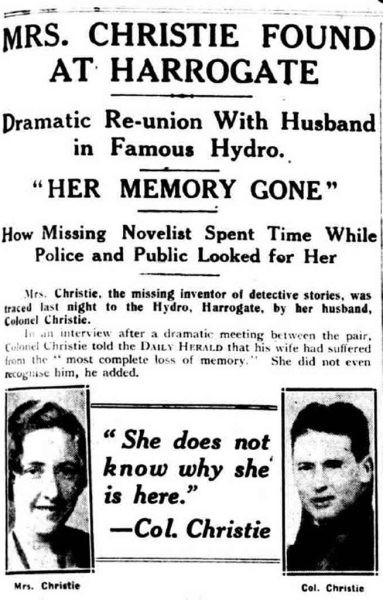Agatha Christie, a name familiar to avid readers of mystery novels, was one of the greatest English crime novelists in the early 20th century. Her pieces, such as And Then There Were None, Murder on the Orient Express, and Death on the Nile, left an indelible mark on the mystery literature genre. As a female novelist in the 20th century, she emerged as a rising star, capturing the attention of all.

According to the BBC’s History Extra, she vanished on December 1926, at the peak of her fame. Despite the strong mobilization of police involvement due to her prominent fame, progress in the search for her was slow. Following the information, her last known interaction was a goodnight kiss to her daughter, and no other evidence was found. Civilians and her passionate fans blamed the police for their incapability and volunteered to join the investigation in search of her. The valid reason for civilian interference was clear: the police were neglecting the situation. As reported on Medium, police discovered that on the night she went missing, “her car was abandoned on a steep slope at Newlands Corner near Guildford.” Unfortunately, her body was still missing.
During that time, Christie’s husband, Archie, was having a secret affair with a mistress named Nancy Neel, and rumors about their divorce were emerging, according the National Archives. On December 11, Christie left three mysterious letters, each one respectively to her secretary, her brother-in-law, and Archie. The letter sent to her brother-in-law claimed she would enjoy a luxurious stay at the Yorkshire Hotel Spa. The other letter sent to the secretary contained detailed information about her schedule. However, the last letter, sent to Archie, was refused to be revealed to the public due to privacy concerns. Surprisingly, Agatha’s maid claimed to have witnessed him burning the letter the next day. When this rumor spread, the issue received more spotlight, and Christie’s mysterious letters complicated the case even more.
During the challenges of the investigation, two experts emerged to lend their expertise. According to The New York Times, Sir Arthur Conan Doyle, the father of Sherlock Holmes, and Dorothy L. Sayers, the author behind The Lord Peter Wimsey Series, was on a mission to solve this case.
Arthur Conan Doyle took one of Christie’s gloves as a source of evidence and initiated his investigation. He hoped it might bring an answer to her disappearance. Unfortunately, it did not. Next was Dorothy Sayers, who claimed to have visited the site of Christie’s disappearance expecting new clues. However, she couldn’t find any useful evidence to this mystery.
According to History Daily, on December 14th, eleven days after her disappearance, Christie was found. She was dancing at a hotel with a spa in Yorkshire. This mirrored the contents of the letter she had sent to her brother-in-law. The police faced significant criticism once again for not conducting a thorough investigation. By the time she was found, Christie was in a state where she couldn’t recall anything about herself.
Ultimately, the police failed to find any clues as to how the incident had occurred. However, according to Medium, several questionable aspects came to light. For instance, the name she used to book the hotel was not her own. She had registered under the name Theresa Neel, which was the name of Archie’s mistress. Furthermore, Agatha Christie’s memory loss remained a mystery, as it occurred suddenly without any external force or event. Experts interpreted that her memory loss could have been caused by excessive stress and psychological shock, but even this explanation lacked a clear understanding. People suspected that she might be intentionally hiding her memories.
There are two prominent theories behind her disappearance. One perspective held that Christie had staged this event to promote her new book, The Murder of Ackroyd. According to this perspective, everything was meticulously pre-planned as part of her show. On the flip side, the other group claimed that it wasn’t her secret plan, but that she had been murdered by her husband. Unlike the first perspective, which lacked sufficient evidence, the second perspective seemed more reasonable.
Like many of her novels, in the last, Christie added a touch of mystery to her disappearance. Still, suspicions remain, and unfortunately, no one has yet solved it.














































































































































